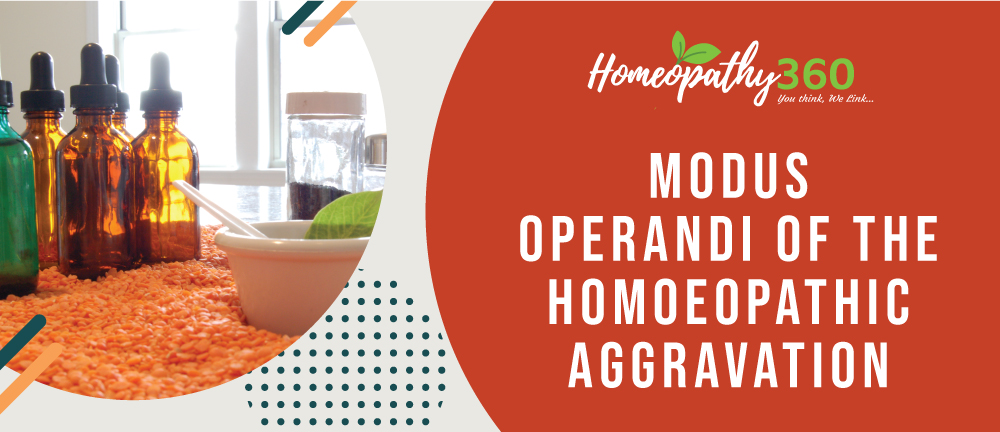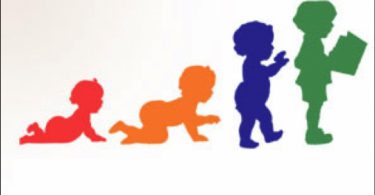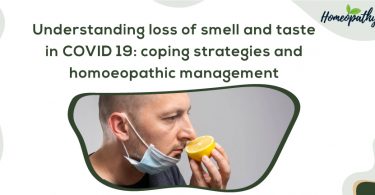
ABSTRACT
Homoeopathic aggravation is intensification of the existing symptoms of the disease following the prescription of the simillimum. A slight intensification is the desired outcome for a good prognosis of the chosen medicine. Understanding the phenomenon of this intensification of the symptoms after taking a correctly chosen medicine followed by cure is very important to understand the modus operandi of homoeopathic cure. This article aims to exemplify the concept of homoeopathic aggravation as described in Organon of Medicine and explain its modus operandi in relevance to cure.
Keywords: Homoeopathic aggravation, modus operandi, homoeopathic medicine
INTRODUCTION
MODUS OPERANDI, is a latin phrase, approximately translated as mode of operating. In Homoeopathy it deals that how homoeopathic cure takes place. Homoeopathic aggravation is actually the part of treatment. It has a very good prognosis if one finds this aggravation in any case during treatment. Just to give intellectual interpretation of the fact, Hahnemann offers a most probable explanation of the mechanism of cure by homoeopathic remedy in aphorism 28, 29, 148 of Organon of Medicine.
After administration of the homoeopathic remedy which is the most simillimum for a particular case, there is a slight and apparent intensification of the existing symptoms of the patient takes place, but the patient feels better in spite of the aggravation of the symptoms. This is known as homoeopathic aggravation. This happens when the seat of the natural disease is occupied by the medicinal disease, which is produced by the exact simillimum after administration; both touch the same part of the diseased organism. Now the natural disease is over powered by the artificial medicinal disease which is somewhat stronger, similar and affects the organism in its dynamic plane. This phenomenon is truly justified by the Hahnemann in aphorism 26:
“A weaker dynamic affection is permanently
extinguished in the living organism by a stronger one, if the latter (whilst
differing in kind) is very similar to the former in its manifestations”. [1]
Aggravation means the increase of intensity or degree of suffering. Each aggravation of symptoms or the appearance of new symptoms, when nothing untoward has occurred in the mental or physical regimen, invariably proves the unsuitability of the given medicine, either the remedy itself or its potency or dose.
Many patients have a question like how is it possible to achieve cure with a medicine which aggravate the present complaint of a patient. It is very difficult to realise this, if he has no knowledge of homoeopathy. A physician often has to confront such questions from many patients. Some patients refuse to undergo homoeopathic treatment on hearing the possibility of such aggravation. Hence, it is the bounden duty of every homoeopath to realise its significance correctly and clarify it to the patients and also the public at large.
There is no doubt that the homoeopathic medicine is similar and stronger as well. But in the potentised medicine, the material quantity of the medicinal substance is so significant that the crude action comes almost to negligible, only the dynamic action remains. This dynamic action also persists for a limited period of time ……..a few minutes or a few hours, in case of acute diseases and a few weeks in case of chronic diseases.[ii]
DISCUSSION
MODUS OPERANDI OF HOMOEOPATHIC CURE
When homoeopathic medicine is applied in a disease on the basis of accurate similarity of symptoms, it affects morbidly deranged dynamic vital force through the medium of sentient faculty of nerves, and thus produces (due to primary action of medicine) a similar but stronger disease against the existing one. The new similar artificial disease is always stronger than the natural disease as it is produced by medicine. The medicinal diseases are always stronger in strength than natural disease because,
- Medicines act unconditionally
- They act all times
- They act under all circumstances
- They act on every individual
- Regulation of dose in our control.
- Medicines prevent diseases.
- Medicine can cure, palliate and suppress the natural diseases
- The disease makes the person hypersensitive or very much susceptible to the influence of similar medicine. Because of this increased susceptibility minute dose of the medicine is sufficiently superior to overpower the disease.
As per the nature’s law of cure, the natural disease will be removed permanently by the by the stronger similar medicinal disease which will occupy precisely the place of the former. This is the time were there is a slight and transient alleviation of the former symptoms takes place, which we called as HOMOEOPATHIC AGGRAVATION.
Now after this there is only one disease in the system (organism) namely the medicinal disease. So the vital force is now only medicinally diseased. But the instinctive vital force, which is now merely medicinally diseased (though in a stronger degree) is compelled to direct an increased amount of energy. On the other hand, the medicinal disease gradually becomes weaker and weaker due to the – minuteness of the dose of the medicine, shorter and fixed duration of action of the medicinal agent, as there is similar relation between drug and disease, the vital force indifferentiates itself and employs its increased energy to extinct the medicinal disease. As the medicinal disease is growing weaker and weaker, finally a time will come when the vital force will overcome the medicinal disease. Now the vital force is free from both the natural disease as well as the medicinal disease and enabled to carry on healthy the vital operations of the organism. Thus, health is restored. Natural disease is removed by the primary action of the administered medicine and the substituted artificial (medicinal) one is removed by the secondary curative action of the vital force.[iii]
ROLE OF VITAL FORCE IN MODUS OPERANDI AND HOMOEOPATHIC AGGRAVATION
After the administration of the medicine, Hahnemann has mentioned in aphorism 63 and 112, “every agent that acts upon vitality, every medicine, deranges more or less the vital force, and causes a certain alteration in the health of the individual for a longer or shorter period. This is termed as primary action”. During the primary action of the medicine, the vital force plays a receptive role; it simply receives the impressions produced by it. Vital force is compelled to permit the alterations and changes takes place in the organism.
Secondary action explained in aphorism 64 of Organon of Medicine. When the exact opposite of the primary action is not possible in nature, the vital force indifferentiates itself and employ its increased energy to extinct the medicinal disease which gradually decreases spontaneously due to its minute quantity and limited duration of its action. Now the vital force is free from all diseases and become able to carry on vital operations normally for the betterment for the individual. When an exact opposite condition of the primary action is possible, the vital force reacts equally and opposite to the primary action this is called secondary counter action. This action is proportionate to the intensity of the primary action of the drug and also the condition of the constitution. This occurs due to large doses, takes place in antipathic mode of treatment.
In acute diseases, homoeopathic aggravation occurs for the first few hours after the ingestion of the medicine. In chronic cases, this aggravation seen in the course of six, eight, or ten days while a general improvement becomes visible in the intervening hours.
REVIEW OF LITERATURE
HISTORICAL BACKGROUND
Hahnemann started to observe in a way in 1796, while ‘HOMOEOPATHIC AGGRAVATION’ has been detected much later by the other school of medicine and called ‘rebound phenomena’ The earliest statement of Hahnemann regarding aggravation is in the ‘Essay on a New Principle for Ascertaining the Curative Powers of Drugs’ published in 1796 in Hufeland’s journal. This is indeed his very first writing about similia. Therefore, ideas on medicinal aggravation started with the very origin of similia application. He writes therein: “If, in a case of chronic disease, a medicine be given whose primary action corresponds to the disease, the indirect secondary action is sometimes exactly the state of the body sought to be brought about, but sometimes, (especially if a wrong dose has been given) there occur in the secondary action, a derangement for some hours, seldom days. A somewhat too large a dose of henbane is apt to cause in its secondary action great fearfulness….”
At this time aggravation in his analysis is due not to the similarity of the primary action of the drug and already existing symptoms, but to a secondary effect. Ideas on homoeopathic aggravation evolved only gradually from Hahnemann practice, from aphorism 154-161, including the footnotes to 160-161. Related to this subject is also mentioned in the footnote of aphorism 253, 275, 276, 280 and 282. In the sixth edition, in addition to these, there is aphorism 248. In the last edition, Hahnemann mentions a “belated aggravation” The dose potency and repetition are closely interlinked with aggravation. It is clear that Hahnemann discovered that the similar remedy aggravates the disease if given in crude form and in material doses. In aphorism 282 of Organon of Medicine he expresses that it would be a certain sign that the doses were altogether too large, if during treatment, especially in chronic disease, the first dose should bring forth a so called homoeopathic aggravation.[iv]
In aphorism 279, “it has been fully proved by pure experiments that when a disease does not evidently depend upon the impaired state of an important organ the dose of the homoeopathic remedy can never be so sufficiently small so as to be inferior to the power of the natural disease which it can, at least, partially extinguish and cure, provided it be capable of producing only a small increase of symptoms immediately after it is administered”[v]
Sehron called the idea of homoeopathic aggravation “an unfortunate dogma” and denied the Hahnemann’s view in too. Rummel held that while the homoeopathic aggravation was rare it was seen occasionally. Kurtz stated thataggravations occur when the drug is too strong or too weak; in the latter instance, they are associated with the lack control of the natural disease. They do not occur with a truly homoeopathic remedy. Going back to the Hahnemanns’s time, Schmidt believed that aggravations occurred only from too small doses and were evidence of their inefficient attempt to overcome disease. Kampfer divided aggravations into those which were followed by improvement and those followed by no change. Hirschel described several types of aggravation: aggravations due to hypersensitivity of the organism, those due to the drugs being incorrectly chosen and producing new symptoms aggravation followed by cure and aggravation without resulting improvement. Schmidt describes several types of aggravation but called Hahnemann’s homoeopathic aggravation “a phantom”. Griessclich, he puts thehomoeopathic aggravation as the psychic effect of homoeopathic theory.
CONFIRMATION OF THE PRESENT DAY CONCEPT
A field in which many of the observations of Hahnemann, are confirmed is in vaccine therapy and desensitisation treatment of allergic conditions, i.e. fields were simila principle is used. Reactive phenomena of the type of homoeopathic aggravation are well known in the desensitization treatment of allergic patients. They have been known to be immediate or delayed, local or systemic and mild to very serious. Thus resembling the different types of aggravation mentioned by Kent.[vi]
According to Kent, true homoeopathic aggravation is, when the symptoms worse but the patient says, “I feel better”. Among the 12 Kent observations, 3rd observation deals with the homoeopathic aggravation – where the aggravation is quick, short, and strong with the rapid improvement of the patient. Improvement will be marked, the reaction of the economy is vigorous, and there is no tendency to any structural change in the vital organs. Any structural change that may be present will be found on the surface, in organs that are not vital.[vii] As the potentised homoeopathic medicines are administered on the basis of similia, they manifest the disease symptoms in different parts according to the order of the appearance of the particular disease. so when the disease manifestations shift from the mental sphere to the physical sphere, the patient mentally feels much better.
PROGNOSIS:
The slightest homoeopathic aggravation during the treatment indicates a very good prognosis. It is a good sign and indicates that it will yield to the first dose. In aphorism 280, Hahnemann indicates that the homoeopathic aggravation indicates – a) An approaching cure b) The vital principle no longer needs to be affected by the similar medicinal disease in order to lose the sensation of the natural disease. c) The life principle now free from the natural disease begins to suffer only something of the medicinal disease hitherto known as homoeopathic aggravation.
Suppose the symptoms are aggravated and the patient reports that he is feeling better but if in fact this is not homoeopathic aggravation, there is a possibility of mistake in prognosis. It will be possible to ascertain that this is disease aggravation. But the patient feels better due to the natural course of the disease. Here, patient is optimistic up to the last about his cure so when questioned, he says that he is well, for example, pulmonary tuberculosis. Hence, it is a case of aggravation of the disease and the selection of the medicine was wrong. So a fresh case-taking should be done and a new medicine covering the symptom-totality should be administered in the earliest opportunity.
The second problem arises when the patient does not feel better in spite of the homoeopathic aggravation. This happens usually in mental diseases as also when the correct drug is unnecessarily repeated.[viii]
CONCLUSION AND DIRECTION AFTER HOMOEOPATHIC AGGRAVATION–
In the 5th and 6th edition of Organon of Medicine, Hahnemann stated thatthe further administration of the medicine is to be stopped as soon as there is homoeopathic aggravation. So, without this initial aggravation, it becomes difficult for us to sure about the correctness of the prescription.
REFERENCES :
[1]Dudgeon R.E., M.D.; Organon of Medicine; reprint edition, New Delhi: B.Jain Publishers (P) Ltd; 2004.
[ii] Dey S.P.; Essentials of Principles and Practice of Homoeopathy; enlarged 3rd edition, Kolkata: Bidhanagar; November 2000.
[iii] Babu N. M.D.; Comprehensive Study of Organon, An Attempt to Understand The Organon Of Medicine as a Scientific Treatise; 11th reprint edition; B.Jain Publishers (P) Ltd.; 2018.
[iv] Harischand D; Article on ‘The Homoeopathic aggravation’ New Delhi -american journal of American Institute of Homoeopathy, june 1977.
[v] Kent J.T.A.M., M.D.; Lectures on Homoeopathic Philosphy; reprint edition, New Delhi:; Indian Books & Periodical Publishers; published by MayurJain; Book CodeNo: IB0534; September2007.
[vi] Harischand D; Article on ‘The Homoeopathic aggravation’ New Delhi -american journal of American Institute of Homoeopathy, june 1977.
[vii] Kent J.T.A.M., M.D.; Lectures on Homoeopathic Philosphy; reprint edition, New Delhi:; Indian Books & Periodical Publishers; published by MayurJain; Book CodeNo: IB0534; September2007.
[viii] Dey S.P.; Essentials of Principles and Practice of Homoeopathy; enlarged 3rd edition, Kolkata: Bidhanagar; November 2000.
About Author:
Dr Vinita Choudhary, PGT
R.B.T.S. Govt. Hom. Med.
College & Hospital, Bihar





